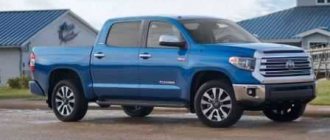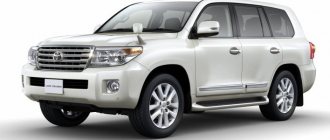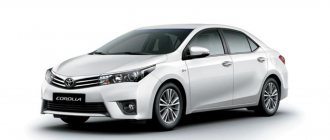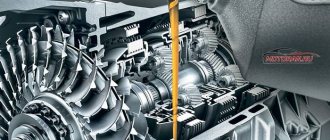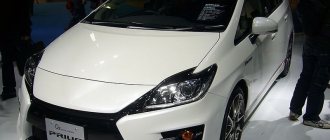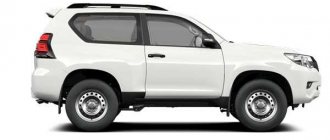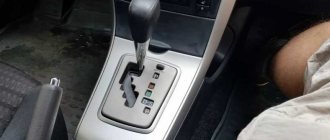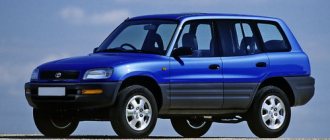Toyota Verso - review, prices, videos, technical specifications Toyota Verso
The new Toyota Verso debuted at the autumn international motor show in Paris. The car is the first planned restyling and, according to the manufacturer, received 470 changes. It will not be difficult to distinguish the new product from its predecessor. Stylish elongated headlights with lensed optics catch your eye. The radiator grille is adjacent to the lighting equipment and consists of two slots with chrome trim. Below it, on the front bumper, is a massive air intake, giving the front of the car a rather aggressive look. On the sides of it, in special recesses, you can see a couple of round fog lights. In general, the car received a completely new, fast-paced and memorable design. If before the restyling the model seemed rather boring and faceless, then the new product, on the contrary, even looks too dynamic for its purpose.
Dimensions of Toyota Verso
Toyota Verso is a compact minivan with 5 or 7 seats. Its overall dimensions are: length 4460 mm, width 1790 mm, height 1620 mm, and wheelbase 2780 mm. Toyota Verso ground clearance, depending on the type of transmission, will be 145 or 155 millimeters. Thanks to this ground clearance, the car will hold the road perfectly, will be able to climb small curbs when parking and will remain stable even at high speeds.
The trunk of the Toyota Verso boasts enviable spaciousness. With the backrests of the third row of seats raised, up to 155 liters of free space remains in the rear. However, if the owner does not plan to take seven passengers on board, the backrests can be folded down to free up to 440 liters. In order to transport a relatively large load, you can sacrifice the second row. In this case, a flat area of 1575 by 1430 millimeters is formed and 1696 liters are released.
Technical characteristics of Toyota Verso
Toyota Verso is equipped with two engines, a CVT or manual transmission, and exclusively front-wheel drive. Thanks to a good and balanced line of units, the car is able to satisfy most of the needs of a potential buyer.
- Basic versions of Toyota Verso are equipped with an in-line naturally aspirated petrol four with a volume of 1598 cubic centimeters. Despite its modest displacement, it produces 132 horsepower at 6,400 rpm and 160 Nm of torque at 4,400 rpm. In this configuration, the car will accelerate to hundreds in 11.7 seconds, and the maximum speed, in turn, will be 185 kilometers per hour. Toyota Verso fuel consumption will be 8.3 liters of gasoline per hundred kilometers at a city pace with frequent acceleration and braking, 5.6 liters during a measured trip on a country road and 6.6 liters of fuel per hundred in the combined driving cycle.
- Top versions are equipped with an engine with a similar layout, but increased to 1798 cubic centimeters in volume. Thanks to the increased displacement, engineers managed to squeeze out 147 cubic centimeters at 6400 rpm and 180 Nm of torque at 4000 crankshaft revolutions per minute. With a manual transmission, the car will reach a hundred in 10.4 seconds, and the speed ceiling will be 190 kilometers per hour. Despite the increased power and good dynamics, efficiency was practically not affected. Toyota Verso fuel consumption will be 8.7 liters of gasoline per hundred in city driving, 5.7 liters on the highway and 6.8 liters in the combined driving cycle.
Bottom line
Toyota Verso keeps up with the times. It has a stylish and memorable design that will perfectly highlight the character and individuality of its owner. This car will look great both in busy city traffic and on the highway. The salon is a kingdom of high-quality finishing materials, well-calibrated ergonomics, and practical comfort. Even a long trip or hours spent in traffic jams will not cause unnecessary inconvenience. The manufacturer understands perfectly well that, first of all, the car should provide driving pleasure. That is why the compact van is equipped with a perfectly balanced line of units that are a fusion of innovative technologies and legendary Japanese quality. Toyota Verso is a practical and reliable car for every day.
Video
Video
The new Toyota Verso debuted at the autumn international motor show in Paris. The car is the first planned restyling and, according to the manufacturer, received 470 changes. It will not be difficult to distinguish the new product from its predecessor. Stylish elongated headlights with lensed optics catch your eye. The radiator grille is adjacent to the lighting equipment and consists of two slots with chrome trim. Below it, on the front bumper, is a massive air intake, giving the front of the car a rather aggressive look. On the sides of it, in special recesses, you can see a couple of round fog lights. In general, the car received a completely new, fast-paced and memorable design. If before the restyling the model seemed rather boring and faceless, then the new product, on the contrary, even looks too dynamic for its purpose.
DIMENSIONS OF TOYOTA VERSO
Toyota Verso is a compact minivan with 5 or 7 seats. Its overall dimensions are: length 4460 mm, width 1790 mm, height 1620 mm, and wheelbase 2780 mm. Toyota Verso ground clearance, depending on the type of transmission, will be 145 or 155 millimeters. Thanks to this ground clearance, the car will hold the road perfectly, will be able to climb small curbs when parking and will remain stable even at high speeds.
The trunk of the Toyota Verso boasts enviable spaciousness. With the backrests of the third row of seats raised, up to 155 liters of free space remains in the rear. However, if the owner does not plan to take seven passengers on board, the backrests can be folded down to free up to 440 liters. In order to transport a relatively large load, you can sacrifice the second row. In this case, a flat area of 1575 by 1430 millimeters is formed and 1696 liters are released.
TECHNICAL SPECIFICATIONS TOYOTA VERSO
Toyota Verso is equipped with two engines, a CVT or manual transmission, and exclusively front-wheel drive. Thanks to a good and balanced line of units, the car is able to satisfy most of the needs of a potential buyer.
- Basic versions of Toyota Verso are equipped with an in-line naturally aspirated petrol four with a volume of 1598 cubic centimeters. Despite its modest displacement, it produces 132 horsepower at 6,400 rpm and 160 Nm of torque at 4,400 rpm. In this configuration, the car will accelerate to hundreds in 11.7 seconds, and the maximum speed, in turn, will be 185 kilometers per hour. Toyota Verso fuel consumption will be 8.3 liters of gasoline per hundred kilometers at a city pace with frequent acceleration and braking, 5.6 liters during a measured trip on a country road and 6.6 liters of fuel per hundred in the combined driving cycle.
- Top versions are equipped with an engine with a similar layout, but increased to 1798 cubic centimeters in volume. Thanks to the increased displacement, engineers managed to squeeze out 147 cubic centimeters at 6400 rpm and 180 Nm of torque at 4000 crankshaft revolutions per minute. With a manual transmission, the car will reach a hundred in 10.4 seconds, and the speed ceiling will be 190 kilometers per hour. Despite the increased power and good dynamics, efficiency was practically not affected. Toyota Verso fuel consumption will be 8.7 liters of gasoline per hundred in city driving, 5.7 liters on the highway and 6.8 liters in the combined driving cycle.
The “technical specifications” section contains basic information about the most popular versions of Toyota Verso. We present data such as engine power and displacement, standard, EURO, number of doors and seats, as well as gearbox type.
Toyota Verso is a compact 5- or 7-seater front-wheel drive class C minivan. It was first presented at the Geneva Motor Show in March 2009 as the successor to the Toyota Corolla Verso. From that time on, the model began to be considered independent and freed itself from the previous prefixes Corolla, Yaris and Avensis.
Compared to the Corolla, the 2009 Toyota Verso has slightly increased in size (gained a couple of centimeters in each direction), which significantly added to its free space, and therefore comfort. Toyota Verso length - 4440 mm, width - 1790, height - 1620; wheelbase – 2780 mm. Five adults and two children, taking with them everything they need, can feel comfortable. When fully seated, the trunk capacity of a 7-seater minivan is only 155 liters, while when the rear row seats are folded, the loading space increases to a respectable 1645 liters. The 5-seater trunk is naturally more spacious: from 440 to 1690 liters.
Using the unique Easy Flat-7 system, 5 rear seats can be folded compactly in a matter of seconds. This system allows you to perform about 32 different actions inside the car (up to changing the volume of the glove compartment). The adjustment range of the middle row of seats reaches 195 mm, and all three seats move independently of each other. All vehicle passengers are provided with the widest possible viewing angle. Especially for parents, a “parental” mirror is installed in the car to monitor children on the road. Thermal, sound and noise insulation of Toyota Verso are performed at a high level and provide high comfort to the driver and passengers.
On the Russian market, the model was offered with 1.6 and 1.8-liter gasoline engines (both 4-cylinder) with a capacity of 132 and 147 hp. respectively. Both engines are equipped with a Valvematic valve mechanism, both are paired with a 6-speed manual transmission, and with the latter engine there is also a Multidrive-S variator, which has the ability to manually change virtual gears. In Europe, diesel engines are also offered: 2.0 and 2.2 liters, with a power of 126 and 177 hp. respectively.
The suspension has a time-tested design: McPherson struts at the front and an H-beam at the rear. The brakes on all wheels are disc, the front ones are ventilated.
There are four levels of equipment: Comfort, Comfort Plus, Elegance, Prestige. A big plus is that even the basic (standard) configuration of the Toyota Verso includes active head restraints on each seat and airbags for all car passengers without exception, and for the driver there is also a special knee airbag.
It is noteworthy that in 2010 this car was recognized as the safest compact van according to Euro NCAP. Safety is protected by 9 airbags, ABS, EBD, BA, VSC, TRC, HAC systems.
The updated Toyota Verso was presented at the Paris Motor Show in the fall of 2012. As a result of fundamental changes and improvements, more than 470 parts of the car were updated, of which about 60% relate to the interior and exterior, and 40% to comfort, driving performance and sound insulation.
The appearance of the car has become much brighter. The first thing that catches your attention about the updated Verso is the big changes in the design of the front and rear bumpers (with an integrated diffuser). The radiator grille now consists of two parts: the upper one connects the headlights with a thin line, and the lower one forms an impressive “mouth” built into the front bumper. The corporate logo became larger and moved down, the front lights became sharper and were replenished with a section of daytime running lights made on LEDs.
The car turned out to be sporty and trim with sharp outlines. Note that the creators of the updated Verso call its appearance dual-zone. This means that the edge of the side stamping, starting at the front bumper and running along the bottom of the front doors, and in the area of the rear doors rising sharply to the roof, visually divides the car into two very unequal parts. The drag coefficient has been noticeably improved and is now only 0.295.
The updated Verso has increased in length by 70 mm and in width by 20 mm. This increase went mainly to second-row passengers, for whom the distance to the front row increased by 50 mm.
The main thing in the cabin is its high practicality, and the main merit in this belongs to the proprietary Easy Flex interior transformation system, which allows you to create the desired configuration from 32 possible inside the cabin by raising or lowering the seat backs in a matter of seconds. Depending on this, the trunk volume will vary from 155 to 982 liters. And if you need to transport large items, by folding the rear row seats you can create a cargo area 157 cm long and 143 cm wide. The interior generally has a spacious feel.
The general style of the interior remains the same, but the quality of finishing materials has become significantly better. The updated Verso uses plastics that are nicer and softer to the touch. Silver inserts have been added, the color palette of leather and fabric upholstery has been updated, the steering wheel, doors and armrest are covered in high-quality Nappa leather. Located in the center of the cabin, the sports instrument panel features white backlighting and new graphics. Inside there are many glove compartments, pockets, and compartments for small items. The glove box is “two-tier”, with the top one being cooled. A panoramic roof can be purchased as an option.
The ergonomics of the driver's seat are excellent: the gearshift lever is located on an elevation and is exactly under the driver's hand, the instrument cluster is turned towards the driver, and the multifunctional steering wheel with control buttons has an optimal thickness. There are no problems with visibility, which is provided by a large glass area and wide exterior mirrors.
For Russian car enthusiasts, Toyota Verso is equipped with both diesel and gasoline engines with reduced fuel consumption and reduced CO2 emissions. The model range includes: two petrol engines of 1.6 liters (132 hp) and 1.8 liters (147 hp), as well as three diesel engines of 2.0 liters (126 hp) and 2.2 l (150 and 177 hp). Gasoline engines are equipped with a proprietary Valvematic variable valve timing system that regulates the duration and height of opening of the intake valves. The power units are paired with two types of transmission: a 6-speed manual transmission or a CVT.
The list of equipment is also impressive: seven airbags, including side curtains, and a stabilization system as standard. Wheels - starting from 16 inches. The buyer can order separate climate control, a rain sensor, navigation, a 10 GB storage device, a leather steering wheel, heated seats, floor lighting when the doors are open, night lights in the side mirrors, a panoramic roof, and a rear view camera. In the version without a navigation screen, the image from the rear view camera will be displayed on a monitor mounted in the driver's mirror.
The level of multimedia capabilities of the car has increased significantly. The buyer is offered two levels. The first level - the Toyota Touch system with a 6.1-inch color touch screen includes a radio with a CD/MP3 player, Bluetooth and a USB port for connecting portable players and a rear view camera. The second level is the Toyota Touch & Go system, which offers a navigation system with various applications that allows you to get useful information: weather forecast, parking, traffic, gas stations, etc. In addition, you can connect to the Internet and view SMS, email messages, calendars, etc. .
To summarize, we can say with confidence that the car has become noticeably better than its predecessor: the appearance has become more stylish, the interior has become larger, more modern optics have appeared, maneuverability has increased, handling has improved, and the list of equipment has sharply expanded.
New Toyota Verso
appeared in 2014, but this is just a restyling of the model that was shown at the Geneva Motor Show in 2009. Technically, Toyota Verso is based on the Toyota Corolla platform. The car received an increased wheelbase, which made it possible to accommodate a third row of seats. Today in Russia you can buy both a 5- and 7-seater version of a minivan. The car is assembled in Turkey.
In Russia, Toyota Verso has two gasoline engines, a manual and a CVT transmission. For the European market, diesel engines with a displacement of 2 and 2.2 liters are also offered. The car has exclusively front-wheel drive. With a length of less than 4.5 meters, the Verso minivan can easily accommodate 7 passengers, this is achieved due to its rather large wheelbase, which is 2,780 mm.
In general, Toyota is very proud of its interior transformation system, which allows you to transport not only passengers, but also various cargo. By the way, in Russia you can buy a Toyota Verso with a panoramic roof. The curb weight of the compact van is more than 1.5 tons. Given that such cars are not in mass demand in our country, Toyota decided to supply the car to Russia in several trim levels.
Exterior of Toyota Verso
, especially in the front, they tried to unify it with the exterior of the Corolla.
The result was a general corporate style. Next, look at the photos of Verso
.
Salon Verso
has nothing to do with the interior of the new Corolla, apparently as a result of the next update this issue will be resolved in favor of unification.
In the backs of the seats, like on an airplane, there are folding tables for rear passengers. More expensive trim levels have a huge panoramic roof and a touchscreen multimedia monitor in the center console. The third row of seats will not please passengers with space; most likely, these seats are designed exclusively for children. Photos of the Verso interior
below.
Toyota Verso trunk
deserves a separate discussion. If you fold out the rear rows of seats, you get a completely flat loading platform suitable for transporting anything. In the traveling 7-seater version, the luggage compartment is reduced to a minimum volume. Let's look at the photo of the Verso trunk.
Toyota Verso-S - review, prices, videos, technical specifications Toyota Verso-S
The new Toyota Verso-S was presented to the general public at the Paris International Motor Show. The model is to some extent a unique car for this market and is able to offer a set of quite attractive qualities. It has a stylish and original design. What catches your eye are the elongated, shaped headlights, extending almost the entire length of the short hood. The radiator grille is a narrow elongated slit with a chrome trim, above which the manufacturer's logo is located. Below, on the front bumper, there is a large air intake, covered with a plastic grille consisting of many thin intersecting horizontal and vertical ribs. In general, the car has a rather interesting, but at the same time unobtrusive design, which perfectly emphasizes its purpose and technical content.
Dimensions of Toyota Verso-S
Toyota Verso-C is a B class compact van and one of the most spacious cars in its segment. Its overall dimensions are: length 3990 mm, width 1695 mm, height 1595 mm, and wheelbase 2550 mm. The ground clearance of the Toyota Verso-S is 145 millimeters. This ground clearance is typical for most city cars. They hold the road well, can climb small curbs while packing, and do not lose stability at high speeds.
The trunk of the Toyota Verso-S boasts good spaciousness. With the backrests of the second row of seats raised, up to 429 liters of free space remains in the rear. Thanks to this volume, the car can easily cope with the daily tasks of a city dweller and can at any moment go on a long trip with an abundance of luggage and several passengers on board. If, by a whim of fate, the owner needs to take on board a larger cargo, he can always fold down the back rows and free up to 1388 liters.
Technical characteristics of Toyota Verso-S
Toyota Verso-S is equipped with two engines, CVT or manual transmissions, and exclusively front-wheel drive. Thanks to a fairly wide range of units, the car becomes quite versatile and is able to satisfy most of the needs of a potential buyer.
- Basic versions of the Toyota Verso-S are equipped with an in-line naturally aspirated petrol four with a volume of 1329 cubic centimeters. Despite its small displacement, it produces 99 horsepower at 6000 rpm and 128 Nm of torque at 3800 rpm. With a manual transmission, the car will accelerate to hundreds in 13.3 seconds, and the maximum speed, in turn, will be 170 kilometers per hour. Fuel consumption of the Toyota Verso-S will be 5.5 liters of gasoline per hundred kilometers at a city pace with frequent acceleration and braking, 4.8 liters during a measured trip on a country road and 6.8 liters of fuel per hundred in the combined driving cycle.
- The top versions of the compact van boast an in-line turbocharged diesel four with a volume of 1364 cubic centimeters. Thanks to a turbocharger and a common rail system, engineers were able to squeeze out 90 horsepower at 3800 rpm and 190 Nm of torque in the range from 1800 to 3000 rpm. With such an engine, the compact van will be able to reach a speed of 175 kilometers per hour and accelerate to hundreds in 12.1 seconds. Diesel power units have always been famous for their good low-end traction and efficiency. Fuel consumption of the Toyota Verso-S will be 4.3 liters of diesel fuel per hundred in city driving, 3.9 liters on the highway and 5 liters in the combined driving cycle.
Bottom line
Toyota Verso-S is a compact, but at the same time quite roomy car. It has an unobtrusive and stylish design that will perfectly emphasize the individuality and character of its owner. Such a car will look natural both in busy traffic and on narrow city streets. The salon is a kingdom of high-quality finishing materials, well-adjusted ergonomics, practicality and comfort. Even traveling during rush hour will not cause unnecessary inconvenience. The manufacturer understands perfectly well that, first of all, the car should provide driving pleasure. That is why the compact van is equipped with an excellent line of units that are the quintessence of proven technologies and legendary Japanese quality. Toyota Verso-S is a practical, compact and economical car for the city.
Video
Third generation
This modification further prepared the Corolla Verso for the European car market. Proof of this, among others, can be the fact that the design was developed by the European studio Toyota. After the changes that occurred with the Corolla Verso in 2004, the car body was visually divided into two parts. One of them included panels, front and rear bumpers, extended wheel arches for the Corolla Verso, and the other included a roof with rear side windows extended back, which create the illusion of movement even while the car is standing still. Confirmation of this photo of corolla verso:
Continuing the production of affordable and spacious cars, Toyota has further optimized the new product for the convenience of the families for which the Corolla Verso is designed. So the third generation has new technical characteristics and features. The Verso's interior turned out to be capable of not only accommodating up to seven passengers, but also changing to suit any whim or need of its owners. For example, for a large amount of luggage or items of non-standard sizes, you can fold all the seats of the Corolla Verso, except the front ones.
The interior of the Corolla Verso, although not replete with design features, all the details are made of high-quality materials that were previously unavailable for this class of materials.
In the Toyota Corolla Verso trim levels, there are two options for engine sizes, both gasoline and diesel units. In the first case, the choice was between 1.6 and 1.8 liters, in the second - 2 or 2.2. The Verso gearbox, depending on the configuration, can be a simple 5-speed manual or robotic manual.
What is especially important in a family car, the Toyota Corolla Verso has an excellent safety system, including 9 airbags, a persistent warning system with sound and light if one of the passengers has not fastened their seat belt.
Top
TOYOTA Verso technical specifications and photos - 2009, 2010, 2011, 2012, 2013
Body:
Van
Segment:
Mid-size MPV
Toyota's seven-seat family minivan was built in Turkey and has received a renowned name for reliability from the Japanese automaker.
It was presented at the 2009 Geneva Motor Show.
The car appeared on the market at a very unfortunate moment. Not only was the global economy in very poor financial shape, but the MPV market share in Europe was rapidly falling, even though the plan had been drawn up long before production began. Thanks to its good price and decent performance, the Verso stayed on the market for nine years.
Built on the same Toyota New MC platform as the Corolla, Auris, Avensis, Lexus CT and NX, the Verso was the answer to parents who sent cars to and from school. This also ensures a high level of security. The front of the car looked more like a Corolla than an Avensis. This was the right decision, as the compact car was very popular in Europe, where the Verso was sold.
Inside the Verso there was a dashboard with a center-mounted instrument cluster. The design language was a little dated and bland at the time the car was introduced, but it was still suitable for the needs of a family road trip.
The Verso was offered with five petrol or diesel engines producing up to 177 hp, which could move the car and seven people inside quite quickly by the standards of the time.
.
Toyota Verso: technical specifications, dimensions, facts and figures
View all Toyota specifications
Found the Toyota Verso of your dreams? Now you want to know everything about it! With Parkers, you can find out all the key specs of the Toyota Verso from fuel efficiency in MPG and top speed in MPH to running costs, dimensions, data and more. We have the most comprehensive technical specifications available on the Internet
Last news
Toyota Camry upgraded until 2021
It may be one of the best-selling cars in the world, but response to the Toyota Camry in the UK has been lukewarm since its relaunch here in 2021...
The best coupes of 2021
It's time to start shopping for a new car, but this time you really want to make a statement as a four-wheeler. You need something that screams “you.” You do not have …
Qash-ing in: the rise of the family SUV
Ever since the Nissan Qashqai was introduced in 2007, the automotive world has gone crazy. Now you can't drive down a high street without seeing one, and the Qashqai has remained...
Best Hybrid SUVs 2020
Hybrid cars and SUVs are extremely popular among motorists - the former for their environmental friendliness and low operating costs, the latter for their rugged appearance, high performance...
Best Family SUVs of 2021
If your family is expanding and you need a new SUV to cope with your growing brood, here are Parkers' favorites for 2020. With so many SUVs, crossovers...
The Best Small SUVs on Sale 2020
There was a time when choosing all-wheel drive meant serious penalties in terms of fuel economy, performance and handling. But no more - the latest generation of SUVs...
.
GAC-Toyota E'Z (Verso) | ChinaAutoWeb
E'Z is the Chinese version of Toyota Verso. Together with the Corolla, the compact MPV was built by the GAC-Toyota joint venture in Guangzhou, Guangdong Province. The E'Z was unveiled at the 2010 Guangzhou Auto Show and entered the market in June 2011. At the 2012 Beijing Auto Show, GAC-Toyota introduced the crossover version of the E'Z with a sport package. Cross E'Z will be released in late 2013 or early 2014.
Sales are disappointing.
With 17,286 units delivered in 2012, the E'Z ranks 11th in the MPV sector. In 2014, 16,896 units were delivered. 2014 Toyota E'Z (Verso) manufactured by GAC-Toyota
| 160E MT | 180E MT Elite | 180E CVT Elite | 180G CVT Comfort | 180G CVT Lux | |
| Price: MSRP (Chinese Yuan) | 149 800 | 152,800 | 5-seater: 159,800; 7 seats: 169,800 | 5-seater: 169,800; 7-seater: 179,800 | 5-seater: 179,800 7-seater: 189,800 |
| Launch date | October 11, 2013 | ||||
| Transmission | |||||
| Engine | 1ZR-FE 1.6 L (1598 cc) L4 16V DOHC DVVT-i | 2ZR-FE 1.8 L (1,798 cc) L4 16V DOHC DVVT-i ACIS | |||
| Peak power (kW/rpm) | 90/6000 | 103/6400 | |||
| Max. Torque (Nm/rpm) | 154/5200 | 173/4000 | |||
| Compression ratio | 10,2: 1 | 10: 1 | |||
| Transmission | 6MT | variable speed drive | |||
| Front suspension | MacPherson struts | ||||
| Rear suspension | Torsion beam | ||||
| Transmission | Front engine, front wheel drive | ||||
| Brakes (front/rear) | 16" Ventilated Disc / 16" Solid Disc | ||||
| Maximum speed (km/h) | 182 | 185 | 175 | ||
| Steering | EPS | ||||
| Fuel and emissions | |||||
| Combined fuel consumption (l/100 km) | 7.5 | 7,7 | 7,4 | ||
| Tank capacity (l) | 60 | ||||
| Emission level | Euro IV (V in Beijing) | ||||
| Dimensions | |||||
| Overall Length (mm) | 4450 | ||||
| Overall Width(mm) | 1790 | ||||
| Overall height (mm) | 1640 | ||||
| Wheelbase (mm) | 2780 | ||||
| Track (front / rear, mm) | 1530/1540 | ||||
| Ground clearance (mm) | |||||
| Turning radius (m) | 5.4 | ||||
| Curb weight (kg) | 1540 | ||||
| Max. Weight, kg) | |||||
| Capacity | 5 | 5 | 5/7 | ||
| Trunk volume (l) | |||||
| Appearance | |||||
| Tires | 205/60 R16 | ||||
| Power exterior mirrors (with cornering lights) | S | S | S | S | S |
| LED tail lights | S | S | S | S | S |
| Front fog lights | N | N | N | S | S |
| Automatic headlights | N | N | N | S | S |
| Alloy wheels | S | S | S | S | S |
| Heated rear window | S | S | S | S | S |
| Rear spoiler with LED brake light | S | S | S | S | S |
| Electrically operated anti-pinch hatch | N | N | N | S | S |
| Interior | |||||
| Smart Key/One Touch Start/Stop | N | N | N | N | S |
| Power Windows with one-touch anti-pinch protection | S | S | S | S | S |
| Electric door locks | S | S | S | S | S |
| Welcome lights | S | S | S | S | S |
| Leather seats | N | N | N | N | S |
| Power driver's seat and lumbar support | N | N | N | N | S |
| Multi Controls on the steering wheel | S | S | S | S | S |
| Manual anti-glare interior rear view mirrors | S | S | S | S | S |
| Number of speakers | 6 | 6 | 6 | 6 | 6 |
| Eco Drive | N | N | S | S | S |
| USB/AUX-IN | S | S | S | S | S |
| Radio/CD player | S | S | S | S | S |
| Manual air conditioner | S | S | S | N | N |
| Dual zone climate control | N | N | N | S | S |
| Safety | |||||
| Dual front airbags | S | S | S | S | S |
| Dual front side airbags | S | S | S | S | S |
| Side airbags | N | N | N | S | S |
| Driver knee airbag | S | S | S | S | S |
| Child safety doors | S | S | S | S | S |
| Active front head restraints | S | S | S | S | S |
| VSC, TRC, HAC, ABS + EBD, BA | S | S | S | S | S |
| Front seat belt pretensioners and reminders | S | S | S | S | S |
| Remote key | N | N | N | N | S |
| Electronic anti-theft system | S | S | S | S | S |
| Baby chair | O | O | O | O | O |
| Front and rear parking radar | N | N | N | S | S |
S = standard, O = option, N = not available
.
All generations of Toyota Verso
2012 – today
I rest.
2009 – 2012
I
Fast passage
- A Acura
- Alfa Romeo
- Alpina
- Alpine
- Aston Martin
- Audi
- Aurus
- B Bajaj
- Bentley
- BMW
- Brilliance
- Bugatti
- BYD
- C Cadillac
- Caterham
- Changan
- Chery
- CheryExeed
- Chevrolet
- Chrysler
- Citroen
- Daewoo
- Daihatsu
- Dartz Motors
- Datsun
- Detroit Electric
- DFM
- Dodge
- FFAW
- Ferrari
- Fiat
- Ford
- Foton
- G GAC
- GAZ
- Geely
- Genesis
- GMC
- Great Wall
- GTA Motor
- H Hafei
- Haima
- Haval
- Hawtai
- Hennessey
- Honda
- Hummer
- Hyundai
- I Icon
- Infiniti
- Iran Khodro
- Isuzu
- JJAC
- Jaguar
- Jeep
- K KIA
- Koenigsegg
- L Lada
- Lamborghini
- Land Rover
- Lexus
- LIFAN
- Lincoln
- Lotus
- Luxgen
- M Marussia
- Maserati
- Maybach
- Mazda
- Mazzanti
- McLaren
- Mercedes-Benz
- MG Cars
- MINI
- Mitsubishi
- N Nissan
- Opel
- P Pagani
- Peugeot
- PGO
- Porsche
- Proton
- Q Qoros
- Ravon
- Renault
- Rolls-Royce
- S Saab
- Samsung
- SEAT
- SeAZ
- Skoda
- Smart
- SsangYong
- Subaru
- Suzuki
Go
The Toyota Verso is a seven-seater compact van. It can also be supplied in a five-seat version. The current generation of the car debuted in March 2009 at the Geneva Motor Show. The car became the successor to the Toyota Corolla Verso; its development began back in 2000. The concern planned to create a minivan that would meet all the requirements of European roads. The first generation Verso entered the market in 2001. The external design of the car was reminiscent of a Toyota Prius. The almost unchanged style of Toyota Verso was created in 2004 in the Toyota ED2 studio. The Easy Flat 7 system allows the seats to be folded in 30 positions, which increases the luggage compartment volume from 91 liters to 779 liters. The car is equipped with a gasoline or turbodiesel engine. The car is also equipped with all the necessary systems for comfortable driving: climate control, heated windows and seats, electric mirrors, GPS navigator and cruise control. Toyota Verso accelerates to 100 km/h in 12 seconds. Depending on the modification, the car can be equipped with a manual transmission or a 5-speed automatic transmission.
New Toyota Proace Verso presented at the Geneva Motor Show
The new Toyota Proace Verso passenger car will debut at the 2021 Geneva Motor Show, once again demonstrating the versatility of an estate car and the capacity to carry up to nine people across the Toyota range.
In accordance with customer needs, the new model range will include a wide range of passenger carriage models. Available in three grades, the Proace Verso will offer customers a choice of three body lengths across the range, from Compact to VIP. Toyota's new MPV allows up to nine people to travel comfortably with luggage.
For all the news from the Geneva Motor Show, visit our hub page here.
Five diesel power units with power ranging from 94 to 177 hp. Offering a choice of manual, robotic manual and automatic transmissions, they are targeting class-leading CO2 emissions. High specification includes unique, user-friendly equipment such as sliding seats on rails, an opening glass rear door, automatic sliding side doors with foot operation and a panoramic roof. Safety standards are in line with Toyota passenger car safety standards, and the Proace Verso was recently awarded five stars in the Euro NCAP crash test program.
Proace Verso: Design and packaging
There are three case sizes - compact, medium and long. With a length of 4.6 meters and a wheelbase of 2.9 meters, the Compact version offers an excellent ratio of size to space. Although the cabin still has seating capacity for nine, the turning circle of just 11.3 meters makes it easy to maneuver and park in populated areas.
The Medium version has a length of 4.9 meters and a wheelbase of 3.2 meters. The Long version has the same 3.2 meter wheelbase but has a larger rear overhang for greater luggage capacity, increasing the overall length to 5.3 metres. Thanks to practical sliding rear doors on the left and right sides and a folding tailgate, all mode variants are 2.2 meters wide and 1.9 meters high.
Family-level models can be identified by color-keyed bumpers, chrome surrounds on the lower front grille, fog lamps and a separately opening rear door glass as standard. The new Proace Verso comes with a choice of wheels, including 16- or 17-inch steel all-wheel drive hubcaps and alloy wheels. 17 inches, depending on the brand chosen.
The dashboard design features clear analogue dials and ergonomic switchgear. Offering excellent all-round visibility, the SUV-like driving position features a short-throw gear lever mounted next to the steering wheel. The three trim grades are built around entry-level carpeting and durable cloth seating, with premium inserts, metallic trim, premium upholstery and, on top-grade models, center console-mounted full-color infotainment equipment. touch screen.
Proace Verso: class structure and seat formats
Proace Verso offers customers a choice of three classes - Shuttle, Family and VIP. The Shuttle and Family grades are available in compact, medium and long hull variants, while the VIP grade is available in medium and long hull variants.
The Shuttle is designed for self-employed owners for family or commercial use, with low running costs, carpeted floors and higher quality fabric upholstery. It is available in eight or nine seat configurations.
The Family class focuses on space, modularity and comfort for vacationers. Its eight-passenger layout combines captain's chair front seats with rail-mounted, sliding and removable 60:40 second- and third-row seats to provide the versatility and practicality of a station wagon's interior. Second-row passengers enjoy the comfort of airplane-style tables, and all six rear seats are equipped with Isofix.
Designed for use as a utility vehicle and recognizable by its safety glass, the VIP Class offers customers superior equipment features and comfort levels. It also features rail-mounted, sliding and removable second- and third-row seats and offers a choice of six- or seven-seat cabin configurations . Mounted on rails between the two second-row seats, the folding table can be used for the convenience of rear passengers. The latter combines captain's chairs in the front and middle rows with a 60:40 split rear deck, while three rows of dual captain's chairs in the first row represent the ultimate in luxury passenger transport. Unique to VIP, the center row seats in any format can be reversed for a more informal ride.
Proace Verso: Powertrains
The Proace Verso will be available with a choice of five powertrains, with 1.6- and 2.0-litre diesel engines offering a choice of power output and transmission. Thanks to the Stop & Start system they achieve class-leading CO2 emissions.
The 70kW/94 DIN 1.6-litre engine option is available with either a five-speed manual transmission or a six-speed robotic manual transmission. The former generates CO2 emissions of 144–148 g/km, while the latter, equipped with Stop & Start, only 135–139 g/km. A more powerful version of the 1.6-liter unit produces 85 kW/113 hp. Available with a six-speed manual transmission. Thanks to the Stop & Start function, it generates CO2 emissions of 133–137 g/km CO2.
2.0-liter turbodiesel with 110 kW / 148 hp with a six-speed manual transmission, it has a Stop & Start system and emits 139–143 g/km CO2. The 130 kW/177 hp variant of the 2.0-litre unit, available with a six-speed automatic transmission, is the most powerful engine in the range. Equipped with the Stop & Start system, it generates CO2 emissions of 151–159 g/km.
Proace Verso Safety
Earning a five-star Euro NCAP crash test rating, the Proace Verso is equipped with Toyota Safety Sense, a new suite of active safety technologies designed to prevent or mitigate collisions in a wide range of driving situations. Combining millimeter-wave radar and camera technology for enhanced detection capabilities, the new active safety systems of the new Toyota passenger carrier include forward collision warning, autonomous emergency braking, blind spot detection, lane departure warning, driver attention warning, assist system with road signs and intelligent speed adaptation. Adaptive front lighting and automatic high beam.
| 1.6 Diesel | ||||
| Displacement (cc.cm) | 1,560 | 1,560 | 1,560 | |
| Max power hp / kW at rpm) | 94/70 at 3750 | 94/70 @ 3750 | 113/85 @ 3,500 | |
| Maximum Torque (Nm at rpm) | 210 @ 1750 | 240 @ 1750 | 300 @ 1750 | |
| Stop and start | № | Yes | Yes | |
| Transmission | Manual transmission 5 speed | Robotic, 6 speeds | Mechanical 6 speed | |
| Max.speed (mph) | 90 | N.A. | 99 | |
| Acceleration from 0 to 62 mph (seconds) | 15.9 | N.A. | 13,4 | |
| Fuel consumption (combined cycle) | from 50 to 51 | N.A. | 54–55 | |
| CO2 Emissions (combined, g/km) | 144 to 148 | 135 to 139 * | 133 to 137 | |
| 2.0 Diesel | ||||
| Displacement (cc.cm) | 1,997 | 1,997 | ||
| Maximum power (hp/kW at rpm) | 148/100 @ 4000 | 177/126 @ 3750 | ||
| Maximum Torque (Nm at rpm) | 370 @ 2 000 | 400 @ 2 000 | ||
| Stop and start | Yes | Yes | ||
| Transmission | Manual transmission 6 speed | Automatic transmission 6 speed | ||
| Max.speed (mph) | 106 | N.A. | ||
| Acceleration from 0 to 62 mph (seconds) | 11 | N.A. | ||
| Fuel consumption (combined cycle) | 51 to 53 | N.A. | ||
| CO2 Emissions (combined, g/km) | 139 to 143 | 151 to 159 * | ||
| DIMENSIONS (mm) | COMPACT | AVERAGE | LONG | |
| total length | 4.606 | 4.956 | 5,308 | |
| Overall Width | 1,920 | 1,920 | 1,920 | |
| Overall height | 1,905 | 1,890 | 1,890 | |
| Wheelbase | 2,925 | 3,275 | 3,275 | |
.


